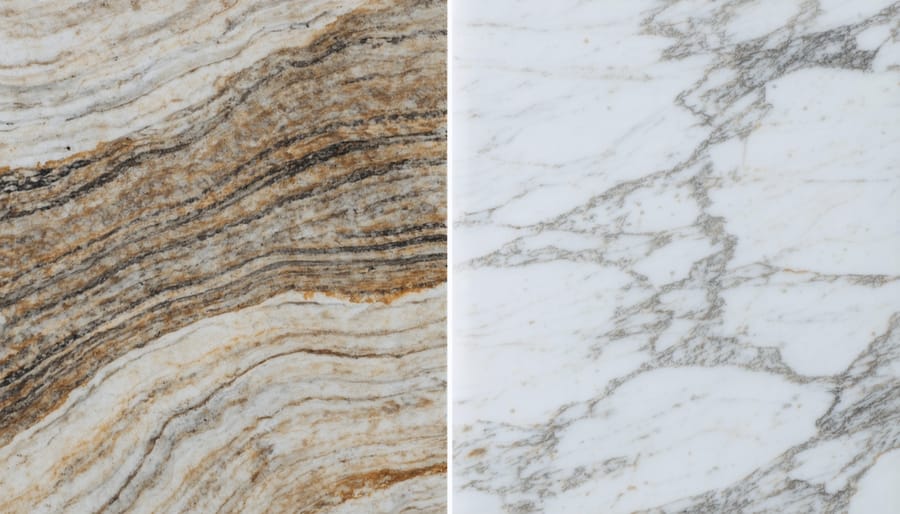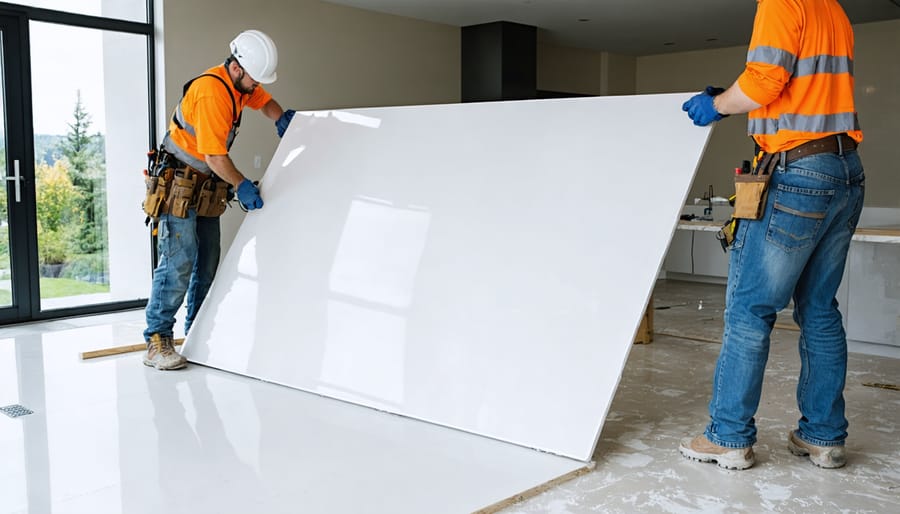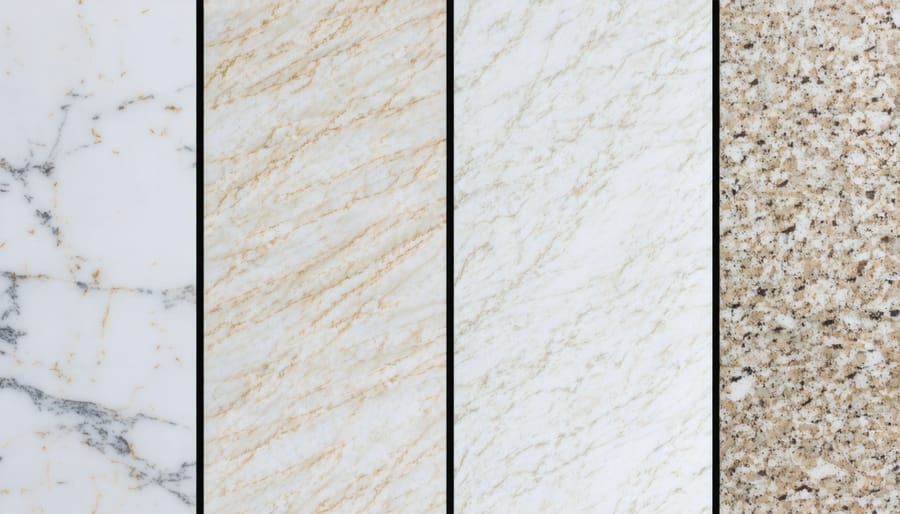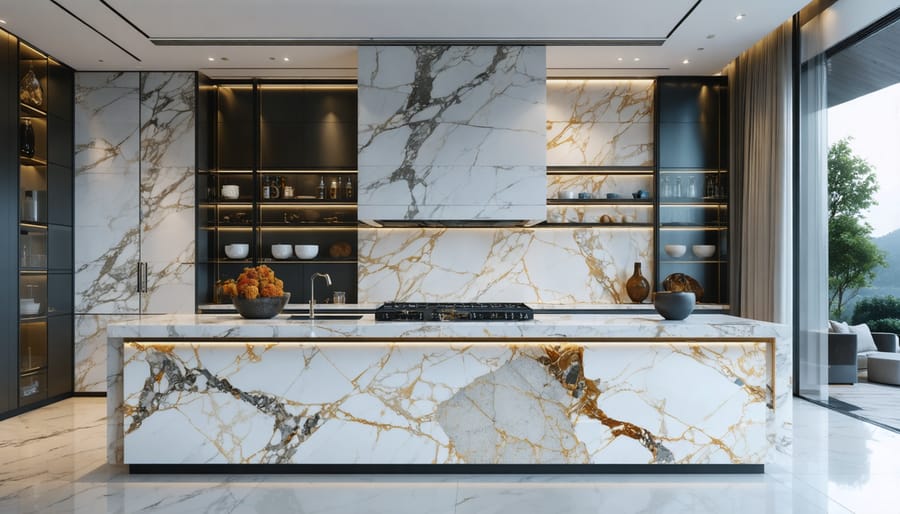Transform your kitchen renovation with lightweight countertop materials that combine modern aesthetics with practical functionality. Today’s innovative alternatives to traditional stone offer remarkable durability at a fraction of the weight, revolutionizing how we approach kitchen design and installation.
These advanced materials – from ultra-compact porcelain and engineered composites to recycled glass surfaces – deliver the luxurious look of natural stone while eliminating common structural concerns and installation challenges. Weighing up to 75% less than granite or marble, these alternatives open new possibilities for upper-floor installations, floating counters, and creative design applications previously limited by weight restrictions.
For homeowners and designers seeking sustainable, cost-effective solutions, lightweight countertop options present compelling advantages: reduced installation costs, easier handling, minimal substrate reinforcement requirements, and exceptional resistance to daily wear. Whether updating a historic home with structural limitations or designing a modern kitchen that pushes creative boundaries, these materials offer the perfect balance of form and function.
This comprehensive guide explores the latest lightweight countertop innovations, helping you make an informed decision that aligns with your design vision, practical requirements, and budget constraints.
Why Choose Lightweight Countertop Materials?

Installation Benefits
Lightweight countertop materials significantly streamline the countertop installation process, offering numerous advantages for both contractors and homeowners. Unlike traditional stone countertops that can weigh upwards of 25 pounds per square foot, lightweight alternatives typically weigh between 4-12 pounds per square foot, reducing the need for specialized lifting equipment and additional labor.
This reduced weight eliminates the necessity for structural reinforcement in most cases, making these materials particularly suitable for upper-floor installations or homes with older cabinetry. Installation teams can handle and maneuver the materials more easily, resulting in faster completion times and lower labor costs. The lighter weight also minimizes the risk of damage during transportation and installation.
Additionally, these materials often come in larger sheets with fewer seams required, simplifying the installation process further. Their manageable weight allows for precise cutting and fitting on-site, reducing the likelihood of measurement errors and ensuring a more accurate final fit. This versatility makes lightweight countertops an excellent choice for both new construction and renovation projects where ease of installation is a priority.
Structural Advantages
Lightweight countertop materials significantly reduce the structural load on kitchen cabinets and floor systems compared to traditional stone options. While granite and marble typically weigh 18-20 pounds per square foot, lightweight alternatives often weigh just 4-7 pounds per square foot. This reduced weight eliminates the need for additional floor support in most installations, making them ideal for upper-floor kitchens and homes with standard floor joists.
Cabinet modifications are rarely needed when installing lightweight countertops, as most standard cabinet configurations can easily support these materials. This advantage becomes particularly important in remodeling projects where existing cabinetry must be preserved. The reduced weight also means easier handling during installation, resulting in lower labor costs and decreased risk of damage to surrounding structures.
For homes with structural limitations or older floor systems, lightweight materials offer a practical solution without compromising on aesthetics or functionality.
Top Lightweight Countertop Options

Porcelain Slabs
Porcelain slabs represent a revolutionary advancement in countertop materials, offering exceptional strength at just 6-12mm thickness. These ultra-thin surfaces are manufactured through advanced pressing and firing techniques, creating panels that combine durability with remarkable lightness. Weighing approximately 2.3 kg per square foot for a 12mm thickness, porcelain slabs are roughly half the weight of traditional granite or marble countertops.
The lightweight nature of porcelain doesn’t compromise its performance characteristics. These slabs boast superior resistance to scratches, heat, UV rays, and chemicals. Their non-porous surface prevents staining and bacterial growth, making them particularly suitable for kitchen applications. The material’s reduced thickness also allows for easier installation and less strain on cabinet structures.
Modern manufacturing processes enable porcelain slabs to mimic natural stone appearances with stunning accuracy. Available in a wide range of patterns and colors, from marble-like veining to industrial concrete looks, these surfaces offer design flexibility without the maintenance demands of natural stone. The material’s lightweight properties make it especially valuable for large-format applications and vertical installations.
While porcelain slabs typically come at a premium price point, their longevity and minimal maintenance requirements often justify the initial investment. Professional installation is crucial, as the material requires specific handling techniques and specialized tools to prevent breakage during fabrication and placement.
Engineered Stone Composites
Recent engineered stone innovations have revolutionized the countertop industry, offering lightweight alternatives that don’t compromise on aesthetics or durability. Modern engineered stone composites typically weigh 30-40% less than traditional granite while maintaining exceptional strength and resistance to daily wear.
These materials combine crushed quartz or other natural minerals with advanced polymer resins, creating slabs that are both lighter and more flexible than conventional stone. Many manufacturers now offer ultra-compact surfaces that can be fabricated in thinner profiles, further reducing overall weight without sacrificing performance.
Notable advantages include enhanced crack resistance, superior flexibility during installation, and improved handling characteristics. The reduced weight also means less structural support is required, making these materials ideal for both new construction and renovation projects where weight restrictions may be a concern.
Color consistency and pattern control are additional benefits, as these engineered products can be manufactured to precise specifications. This allows for seamless matching across large installations and ensures that what you see in the showroom is exactly what you’ll get in your kitchen.
Maintenance requirements are minimal, with most engineered composites featuring non-porous surfaces that resist staining and don’t require periodic sealing. These materials are also highly resistant to heat, scratches, and common household chemicals, making them practical choices for busy kitchens.
Solid Surface Materials
Solid surface materials offer an excellent lightweight alternative to traditional stone countertops, combining durability with design flexibility. These synthetic materials, primarily composed of acrylic resins and mineral fillers, typically weigh between 4-5 pounds per square foot, making them significantly lighter than natural stone options.
Popular brands like Corian, Hi-Macs, and Staron provide seamless surfaces that resist stains and bacteria growth. The non-porous nature of these materials means they don’t require sealing and are exceptionally easy to maintain. Minor scratches and burns can be buffed out, making these surfaces particularly practical for busy kitchens.
One of the most appealing aspects of solid surface materials is their versatility in design. Available in hundreds of colors and patterns, they can convincingly mimic natural stone or create unique, contemporary looks. The material can be thermoformed into curved shapes and integrated with sinks for a seamless appearance.
While not as heat-resistant as natural stone, solid surface countertops offer excellent value for their price point, typically ranging from $40 to $100 per square foot installed. They’re particularly well-suited for modern homes and commercial applications where weight restrictions are a concern.
These materials can be fabricated with built-in backsplashes and edge details, reducing seams and simplifying installation. Their lightweight nature also means less structural support is required, making them ideal for both new construction and renovation projects.
Laminate Solutions
High-pressure laminates (HPL) represent one of the most versatile and cost-effective lightweight countertop solutions available today. These materials consist of multiple layers of kraft paper impregnated with resins and topped with decorative layers, all fused under intense heat and pressure. Modern manufacturing techniques have elevated laminate countertops far beyond their humble origins, now offering stunning replications of natural stone, wood, and metallic finishes.
Today’s premium laminates feature enhanced durability with scratch-resistant surfaces and improved moisture resistance. Many manufacturers now offer textured finishes that convincingly mimic the feel of natural materials, while maintaining the material’s lightweight characteristics. Typically weighing between 2-3 pounds per square foot, laminates are significantly lighter than traditional stone options.
Installation of laminate countertops is straightforward, requiring minimal structural support compared to heavier materials. This makes them particularly suitable for upper-floor installations or homes with weight restrictions. The material can be fabricated with integrated backsplashes and seamless edges, creating a clean, contemporary look.
While laminates are susceptible to heat damage and can show wear over time, their affordability and wide range of design options make them an attractive choice for budget-conscious renovations. Premium varieties now include antimicrobial properties and enhanced wear layers, extending their lifespan and functionality in busy kitchens. When properly maintained, modern laminate countertops can provide years of service while maintaining their appearance.

Durability and Maintenance Considerations
When considering lightweight countertop materials, understanding their durability and maintenance requirements is crucial for making an informed decision. While these materials offer weight advantages, their longevity can vary significantly. For a detailed durability comparison of countertop materials, it’s important to consider both daily wear and long-term performance.
Engineered materials like ultracompact surfaces typically offer excellent scratch and heat resistance, requiring minimal maintenance beyond regular cleaning with mild soap and water. These surfaces don’t need sealing and resist staining, making them ideal for busy kitchens.
Solid surface materials, while susceptible to scratches, have the advantage of being repairable. Minor damage can be buffed out, and more severe scratches can be professionally restored to their original appearance. However, they require careful use of cutting boards and hot pads to prevent damage.
Laminate countertops, among the lightest options, need gentle care to maintain their appearance. While modern variants offer improved durability, they can still be damaged by excessive heat and sharp objects. Their primary advantage lies in easy cleaning and resistance to most household stains.
For maintenance, most lightweight materials benefit from:
– Daily wiping with a soft, damp cloth
– Prompt cleaning of spills to prevent staining
– Using cutting boards and trivets
– Avoiding harsh chemical cleaners
– Regular inspection for potential damage
The longevity of lightweight countertops largely depends on proper care and usage patterns. With appropriate maintenance, many of these materials can last 10-20 years or more. Professional installation also plays a crucial role in durability, as proper support and seaming techniques prevent common issues like separation or cracking.
When selecting a lightweight material, consider your lifestyle and maintenance preferences alongside durability requirements. High-traffic kitchens may benefit from more resilient options, while less frequently used spaces might accommodate materials requiring more careful handling.
Cost Analysis
When evaluating lightweight countertop materials, cost considerations extend beyond the initial purchase price. While traditional granite can cost $40-100 per square foot, many affordable countertop options like engineered stone and ultracompact surfaces range from $30-80 per square foot. Installation costs typically run lower for lightweight materials, as they don’t require additional structural support or specialized equipment for handling.
Porcelain and ceramic surfaces offer excellent value, averaging $25-60 per square foot installed, while maintaining high durability and aesthetic appeal. Recycled glass composites, though slightly higher at $50-100 per square foot, provide unique designs and eco-friendly benefits that can increase property value.
Long-term value analysis favors lightweight materials due to reduced maintenance costs and extended longevity. While premium options like engineered quartz may have higher upfront costs, their resistance to staining and scratching minimizes replacement needs. Budget-conscious consumers can consider laminate options at $20-50 per square foot, though these may require replacement sooner.
Factor in potential savings on structural reinforcement, which can add $200-500 to traditional stone installations. Additionally, lightweight materials often come with longer warranties, sometimes extending to 15-25 years, providing better long-term value protection compared to conventional options.
Selecting the right lightweight countertop material depends largely on your specific needs and priorities. For homeowners seeking maximum durability with minimal weight, engineered quartz composites offer an excellent balance of strength and manageable installation. Those prioritizing budget-friendly options will find laminate and solid surface materials provide practical solutions without compromising aesthetics.
For eco-conscious consumers, recycled glass countertops and bamboo surfaces present sustainable alternatives that maintain the lightweight advantage. Design professionals working on upper-floor installations or renovations with structural limitations should consider ultra-compact surfaces or acrylic-based materials, which offer the look of natural stone without excessive weight loads.
Remember that while initial costs may vary, lightweight materials often reduce installation expenses and eliminate the need for additional structural support. Consider factors such as maintenance requirements, heat resistance, and scratch resistance when making your final decision. Whether you’re designing a modern kitchen or updating a historic property, today’s lightweight countertop options provide solutions that balance functionality, aesthetics, and practical installation requirements.
For optimal results, consult with a qualified contractor who can assess your specific situation and recommend the best lightweight material for your project.










